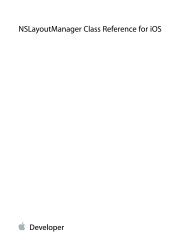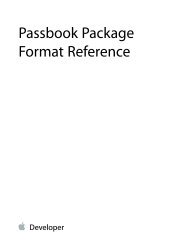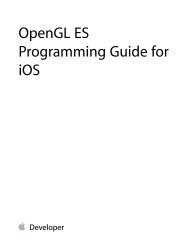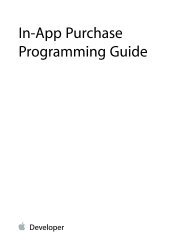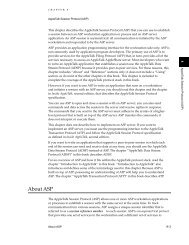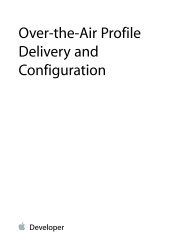URL Loading System Programming Guide - Apple Developer
URL Loading System Programming Guide - Apple Developer
URL Loading System Programming Guide - Apple Developer
Create successful ePaper yourself
Turn your PDF publications into a flip-book with our unique Google optimized e-Paper software.
Using NS<strong>URL</strong>Session<br />
Creating and Configuring a Session<br />
Creating and Configuring a Session<br />
The NS<strong>URL</strong>Session API provides a wide range of configuration options:<br />
●<br />
●<br />
●<br />
●<br />
●<br />
●<br />
●<br />
●<br />
●<br />
Private storage support for caches, cookies, credentials, and protocols in a way that is specific to a single<br />
session<br />
Authentication, tied to a specific request (task) or group of requests (session)<br />
File uploads and downloads by <strong>URL</strong>, which encourages separation of the data (the file’s contents) from<br />
the metadata (the <strong>URL</strong> and settings)<br />
Configuration of the maximum number of connections per host<br />
Per-resource timeouts that are triggered if an entire resource cannot be downloaded in a certain amount<br />
of time<br />
Minimum and maximum TLS version support<br />
Custom proxy dictionaries<br />
Control over cookie policies<br />
Control over HTTP pipelining behavior<br />
Because most settings are contained in a separate configuration object, you can reuse commonly used settings.<br />
When you instantiate a session object, you specify the following:<br />
●<br />
●<br />
A configuration object that governs the behavior of that session and the tasks within it<br />
Optionally, a delegate object to process incoming data as it is received and handle other events specific<br />
to the session and the tasks within it, such as server authentication, determining whether a resource load<br />
request should be converted into a download, and so on<br />
If you do not provide a delegate, the NS<strong>URL</strong>Session object uses a system-provided delegate. In this way,<br />
you can readily use NS<strong>URL</strong>Session in place of existing code that uses the<br />
sendAsynchronousRequest:queue:completionHandler: convenience method on NS<strong>URL</strong>Session.<br />
Note: If your app needs to perform background transfers, it must provide a custom delegate.<br />
After you instantiate the session object, you cannot change the configuration or the delegate without creating<br />
a new session.<br />
Listing 1-2 shows examples of how to create normal, ephemeral, and background sessions.<br />
2013-10-22 | Copyright © 2003, 2013 <strong>Apple</strong> Inc. All Rights Reserved.<br />
19




